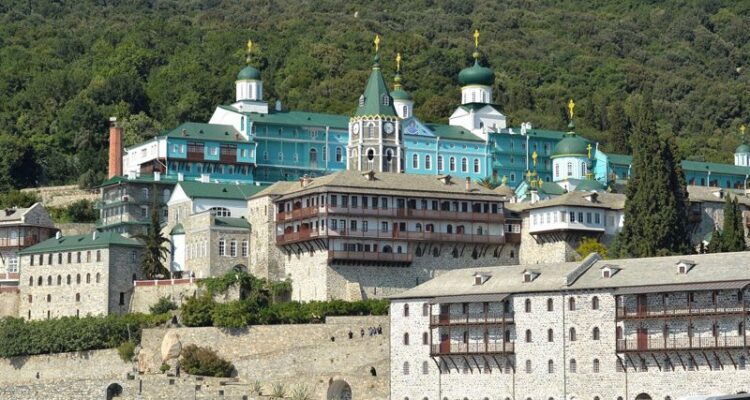The Monastery of Saint Panteleimon was founded at the beginning of the 11th century, on the site of today’s Paleomonastir or Skete of Vogoroditsa. It used to be called Thessalonikeos Monastery and later Xylourgou Monastery.
During the 13th century, the Monastery burned down, and its reconstruction was funded by Andronikos II Paleologos and Serbian rulers. The Monastery has gone through many periods of prosperity and poverty. The monks are mainly of Greek origin, who are around 1497 in total. However, there are also some Russian monks. It was moved to its current location, near the sea, in 1765, under the name Roussiko.
The Katholikon, which is dedicated to Saint Panteleimon, began to be built in 1812 and was finished by 1821. In the 18th century, the Monastery of Saint Panteleimon became Greek property, only for it being repossessed by the Russians again in 1875, where it was decided that services should be held in both the Greek and Russian languages.
During those years, the brotherhood consisted of 1,000 monks, and by the beginning of the 20th century it doubled. The commons was built in 1890 and has a capacity of 1,000 monks. A multitude of icons, relics and vestments are kept in the Monastery.
The library of the Monastery consists of 1320 Greek manuscripts, 600 Slavic and over 20,000 books in Greek and Russian language. Among the treasures of the Monastery, the icons that are standing out are the ones of the Virgin Ierosolimitissa, John the Forerunner, Saint Panteleimon and the mosaic icon of Saint Alexander Nevsky.
In this monastery is also the second largest bell in the world, with a total weight of 13 tons. The Monastery of Sant Panteleimon occupies the nineteenth place in the hierarchy of the monasteries of Mount Athos. It has been communal since 1809 with the sigillium of Patriarch Kallinikos.
It has its components in the Skete of the Dormition of the Virgin or Vogoroditsa, which are two seats, twelve cells, apart from the Karion delegation, as well as the deserted Skete of Thebaid.
Copyright 2023 © Created By Diadyktio, All Rights Reserved.
To provide the best experiences, we and our partners use technologies like cookies to store and/or access device information. Consenting to these technologies will allow us and our partners to process personal data such as browsing behavior or unique IDs on this site and show (non-) personalized ads. Not consenting or withdrawing consent, may adversely affect certain features and functions.
Click below to consent to the above or make granular choices. Your choices will be applied to this site only. You can change your settings at any time, including withdrawing your consent, by using the toggles on the Cookie Policy, or by clicking on the manage consent button at the bottom of the screen.

Congratulation!